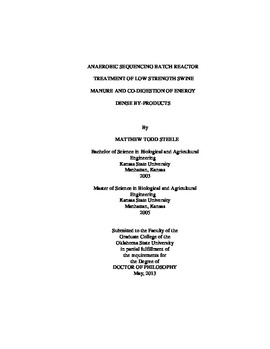| dc.contributor.advisor | Hamilton, Douglas W. | |
| dc.contributor.author | Steele, Matthew Todd | |
| dc.date.accessioned | 2014-09-24T14:16:45Z | |
| dc.date.available | 2014-09-24T14:16:45Z | |
| dc.date.issued | 2013-05 | |
| dc.identifier.uri | https://hdl.handle.net/11244/10990 | |
| dc.description.abstract | The Anaerobic Sequencing Batch Reactor (ASBR) is a batch digester utilizing a single vessel for digestion and solids separation. Internal solids retention provides the ASBR with the ability to treat dilute solids wastewaters such as swine manure. A 430 m^3 full scale ASBR at the Oklahoma State University Swine Research and Education Center was started in August of 2008 using a "cold start" technique and continuously operated for two years. After one year of operation, the HRT was incrementally reduced from 20 to 5 days, and the cycles per day was increased from one to two at a temperature of 20°C. Operation at the final parameters provided organic removals of 64% and a specific methane yield of 0.33 m^3 CH4 kg VS^-1. The dilute natural of swine manure provides the opportunity for co-digestion utilizing the ASBR. Co-digestion of crude glycerol from biodiesel production and swine manure in lab-scale ASBR systems was examined to determine the maximum stable crude glycerol inclusion rate for operation at a 5 day HRT and temperature of 20°C. The maximum inclusion rate for these parameters was found to be 1% (v/v) of the daily influent volume. The 1% inclusion resulted in a 7.3 fold increase in methane production, 21.2 l CH4 day^-1 compared 2.9 l CH4 day^-1 for swine manure only. A 92.5% conversion of crude glycerol COD to methane was observed at the 1% inclusion rate indicating the near complete utilization of co-digestion feedstock. The ASBR has been reviewed in detail lab-scale experiments with limited experience in full scale design and operation. Considerations for the design of a full scale ASBR for treatment of low strength swine manure should be based upon reactor energy balance and solids retention. The low organic loading of low strength swine manure results in low volumetric energy production necessitating the design process to include the reactor's operational input energy requirements with respect to available energy production. The inclusion of the solids separation process within the reactor requires that the physical reactor design be based upon solids settling rates and solids retention capacity of the reactor vessel. | |
| dc.format | application/pdf | |
| dc.language | en_US | |
| dc.rights | Copyright is held by the author who has granted the Oklahoma State University Library the non-exclusive right to share this material in its institutional repository. Contact Digital Library Services at lib-dls@okstate.edu or 405-744-9161 for the permission policy on the use, reproduction or distribution of this material. | |
| dc.title | Anaerobic sequencing batch reactor treatment of low strength swine manure and co-digestion of energy dense by-products | |
| dc.contributor.committeeMember | Atiyeh, Hasan | |
| dc.contributor.committeeMember | Wilber, Gregory | |
| dc.contributor.committeeMember | Carter, Scott | |
| osu.filename | Steele_okstate_0664D_12771.pdf | |
| osu.accesstype | Open Access | |
| dc.type.genre | Dissertation | |
| dc.type.material | Text | |
| thesis.degree.discipline | Biosystems and Agricultural Engineering | |
| thesis.degree.grantor | Oklahoma State University | |
